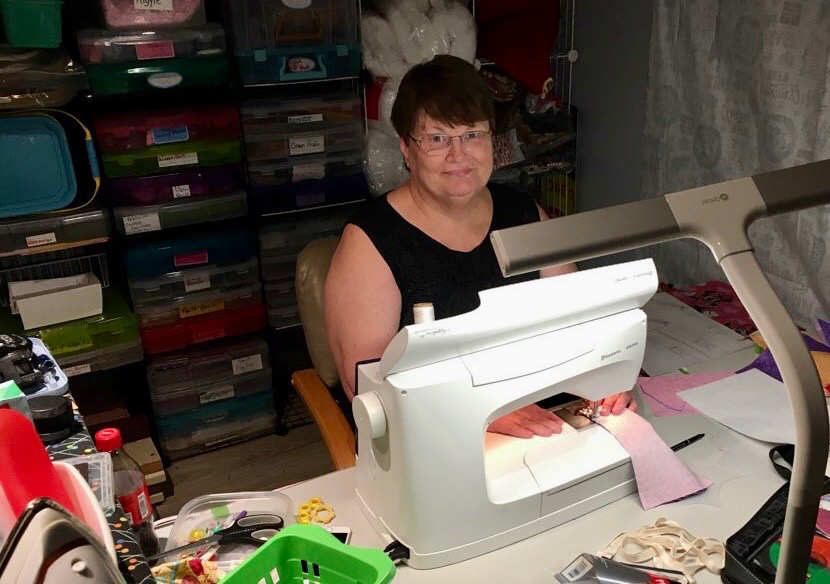Residents-Turned-Seamstresses Help Fill Demand With Homemade Masks
by MARY TOOTHMAN
Before COVID-19 changed daily life, it was usual to grab keys, sunglasses, wallet — and walk out the door to run an errand. But with concerns about the contagious virus spreading as fast as the virus itself, another item has been added to the list of things to grab before leaving home: a mask.
People have found many ways to cover their nose and mouth while in public, some with vast degrees of creativity. One of the most heartwarming trends to unfold has been the emergence of seamstresses who have uncovered their sewing machines and gone to work crafting masks.
Lakeland’s Joy Winburn, who pieces together beautiful quilts, has found that after making a few masks for friends and relatives, she was on her way to mass mask-making.
“I have mailed them to different cousins, to aunts, to my brother-in-law, all over,” Wilburn says. “Everybody needs one.”
She obtained instructions on how to make the masks on YouTube. “At this point, I have made well over 200 of them,” she says.
While there have been challenges for the mask-makers because it can be tough finding fabric and elastic, Wilburn laughed when asked if she has enough fabric to keep up her mask production pace.
“When I ever run out of fabric, well, that would be something,” she says. After sewing all her life, she’s got plenty of fabric pieces on hand, she says.
While medical experts say the handmade masks are not as effective as high grade N-95 masks, they seem to agree that they do help — plus they free up surgical masks for people who are in the highest risk situations.
An N-95 mask is a particulate-filtering facepiece that meets the N-95 standard of the U.S. National Institute for Occupational Safety and Health air filtration rating. That means it filters at least 95 percent of airborne particles. Some of those who are in high-risk situations are wearing homemade masks on top of their higher grade masks to prolong usage time.
According to the Center for Disease Control (CDC), face masks should fit snugly but comfortably against the sides of the face and be secured with ties or ear loops. They should feature multiple layers of fabric, allow for non-restricted breathing,and be able to be laundered and machine-dried without damage or change to shape. On its web page, the CDC recommends wearing cloth face coverings in public settings where other social distancing measures are difficult to follow — such as grocery stores and pharmacies. And it is especially important to comply in “areas of significant community-based transmission.”
The CDC also advises the use of simple cloth face coverings to slow the spread of the virus and keep people who may have the virus and do not know it from transmitting it to others. Cloth face coverings fashioned from household items or made at home from common materials at a low cost, it advises, can be used as an additional, voluntary public health measure.
Cloth face coverings also should not be used on children under 2, anyone who has trouble breathing or is unconscious, incapacitated or otherwise unable to remove the mask without assistance.
The cloth face coverings recommended are not surgical masks or N-95 respirators. Those are critical supplies that must continue to be reserved for healthcare workers and other medical first responders, the CDC says.
Another local seamstress staying busy making masks is Cindy Rodriguez, a Lakeland public relations specialist. She says she has always enjoyed sewing as a hobby. “I am an occasional seamstress,” she says. “But I have sewn my whole life.”
She made matching outfits for her granddaughter and her American Dolls, and stitched up other fun projects. But the need for protective masks during this COVID-19 pandemic brought a whole new category to her sewing projects.
She was called into sewing service, so to speak, when her daughter-in-law, Samantha Rodriguez, asked her to sew some masks. A nurse anesthetist, she asked for masks that could be used to cover N-95 masks. “She sent me a YouTube video, and I said, ‘Yeah, I’ll take a stab at it.’ So far I’ve made about 60 masks.”
It’s been an endeavor of kindness, but it has also been beneficial, when cooped up at home social distancing, to have a project. “It has kept me from going stark raving mad,” she says.
Rodriguez has also found her mask-making ability to be in high demand. Once word got out, it just began to spread. “People would tell me, ‘Well, I sure would like to have one.’ So of course I kept making them. I am just happy to be able to help someone out.”
